Abstract
The binding of the transport inhibitor, forskolin, to the galactose-H+ symporter, GalP, of Escherichia coli was evaluated by equilibrium and time-resolved fluorescence measurements. A quench in protein fluorescence of 8-12% was observed upon the binding of forskolin. The overall dissociation constant (Kd) for forskolin determined by fluorescence titration ranged between 1.2 and 2.2 microM, which is similar to that reported from equilibrium dialysis measurements of the binding of [3H]forskolin (Kd = 0.9-1.4 microM). The kinetics of forskolin binding were measured by stopped-flow fluorescence methods. The protein fluorescence was quenched in a biphasic manner; the faster of these two rates was dependent on the concentration of forskolin and was interpreted as the initial binding step from which both the association (kon) and dissociation (koff) rate constants were determined. The association and dissociation rate constants were 5.4-6.2 microM-1.s-1 and 5.1-11.5 s-1 respectively, and the Kd was calculated to be 1.5 microM. The binding of forskolin was inhibited by D-galactose, but not by L-galactose, and displacement by sugar provided an additional method to calculate the dissociation rate constant for forskolin (koff = 12.4-13.0 s-1). The rate of the slow change in protein fluorescence (3-5 s-1) was independent of the forskolin concentration, indicating an isomerization of the transporter between different conformations, possibly outward- and inward-facing forms. These kinetic parameters were determined at a series of temperatures, so that the thermodynamics of forskolin binding and transporter re-orientation could be analysed. The binding process was entropically driven (delta S = 83.7 J.K-1.mol-1; delta H = 8.25 kJ.mol-1), similar to that for cytochalasin B, which is also an inhibitor of GalP. Measurements of the binding of [3H]forskolin by equilibrium dialysis revealed competitive displacement of bound forskolin by cytochalasin B, possibly suggesting that the sugar, forskolin and cytochalasin B binding sites are overlapping; the Kds for forskolin and cytochalasin B were calculated to be 0.85 microM and 4.77 microM respectively, and the concentration of binding sites was 10.2 nmol.mg-1.
Full text
PDF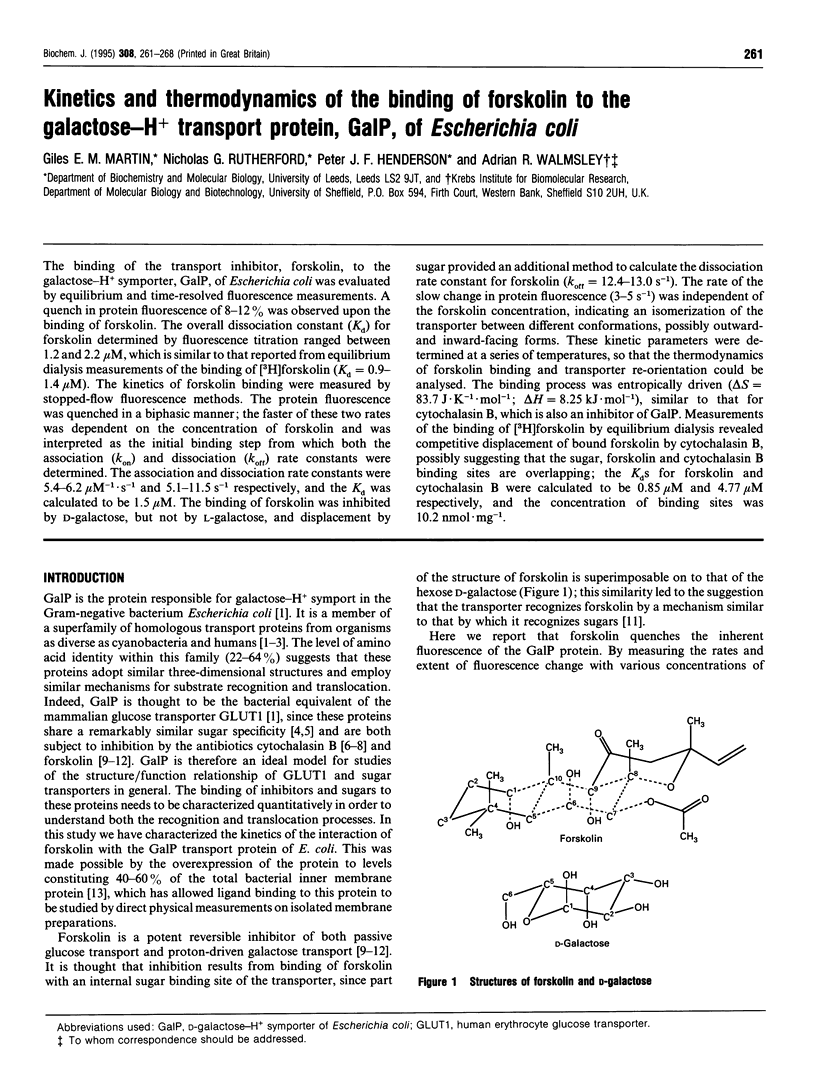
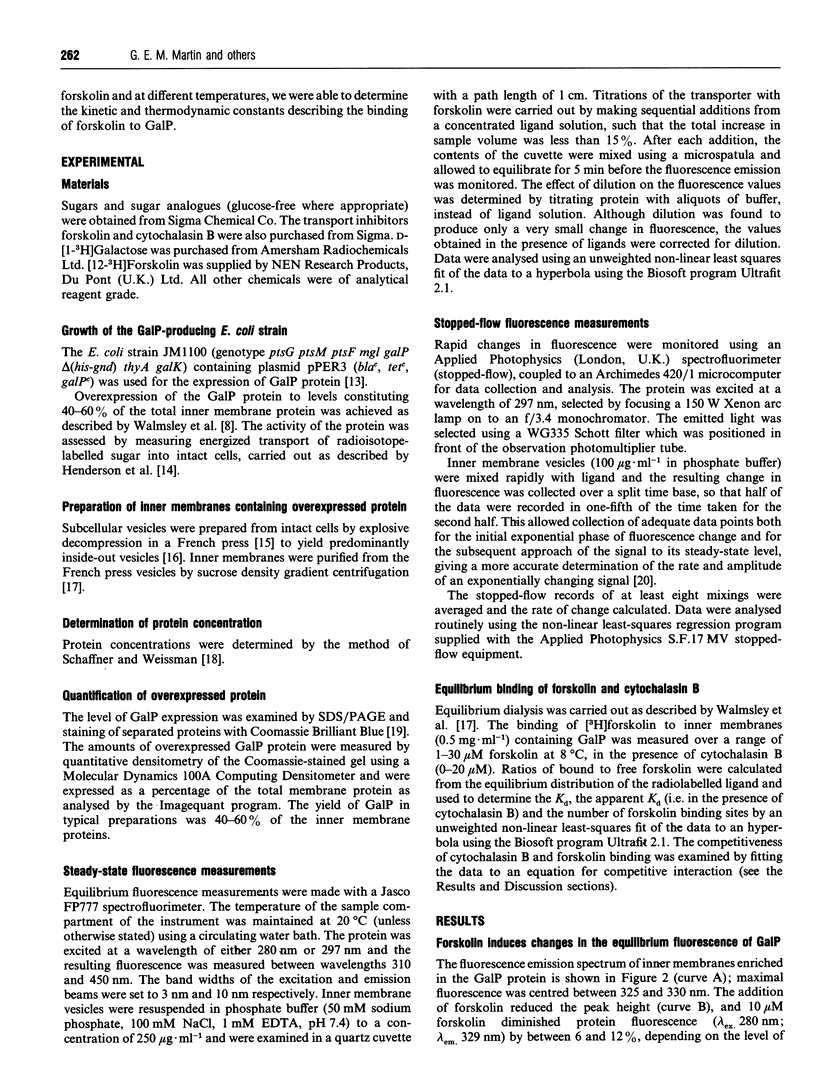
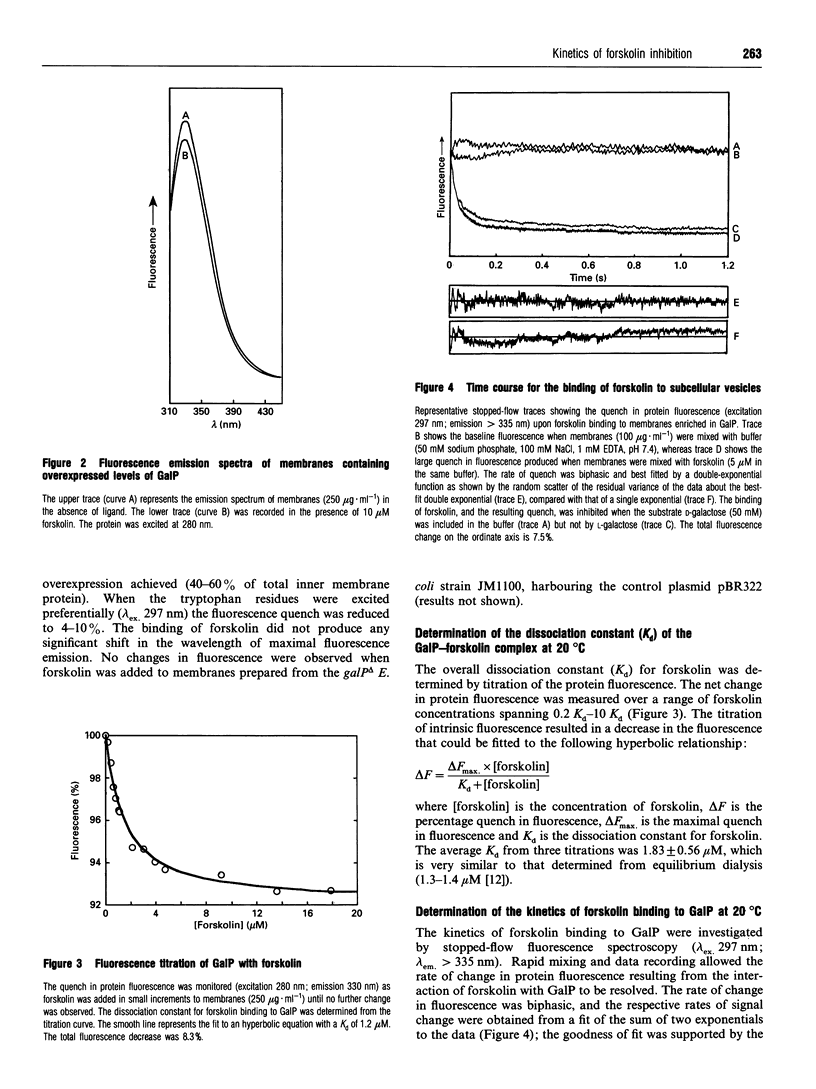
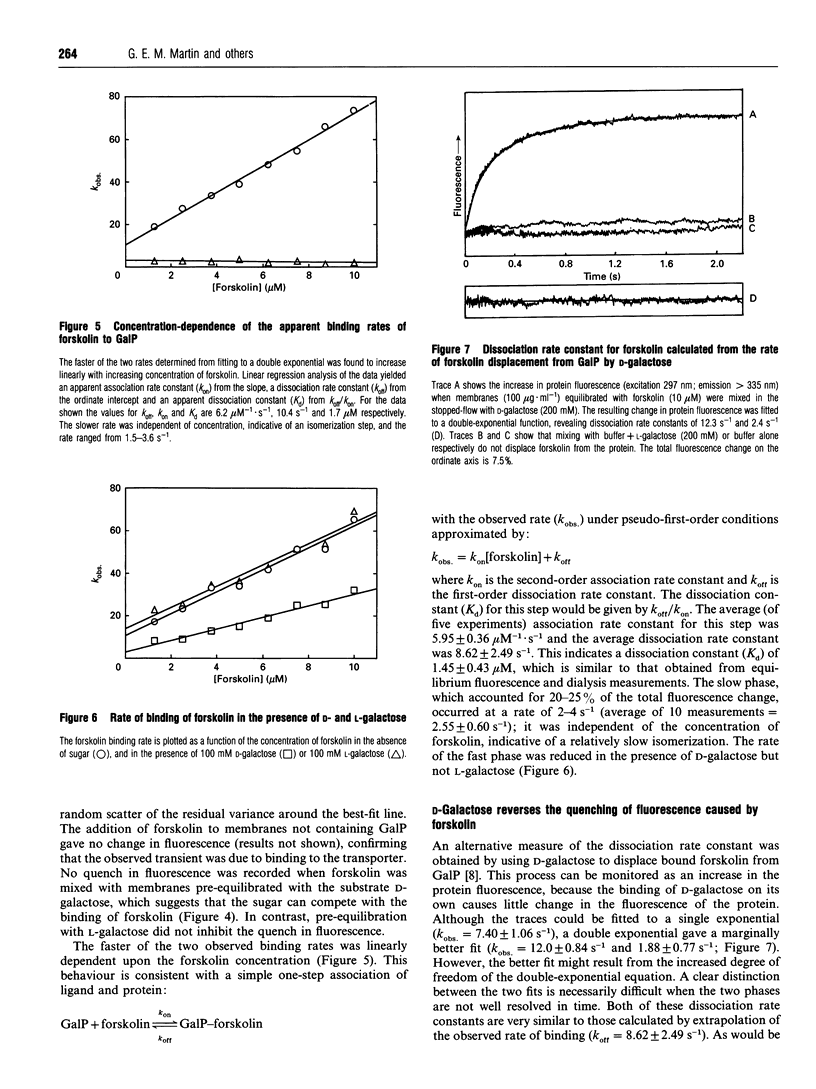
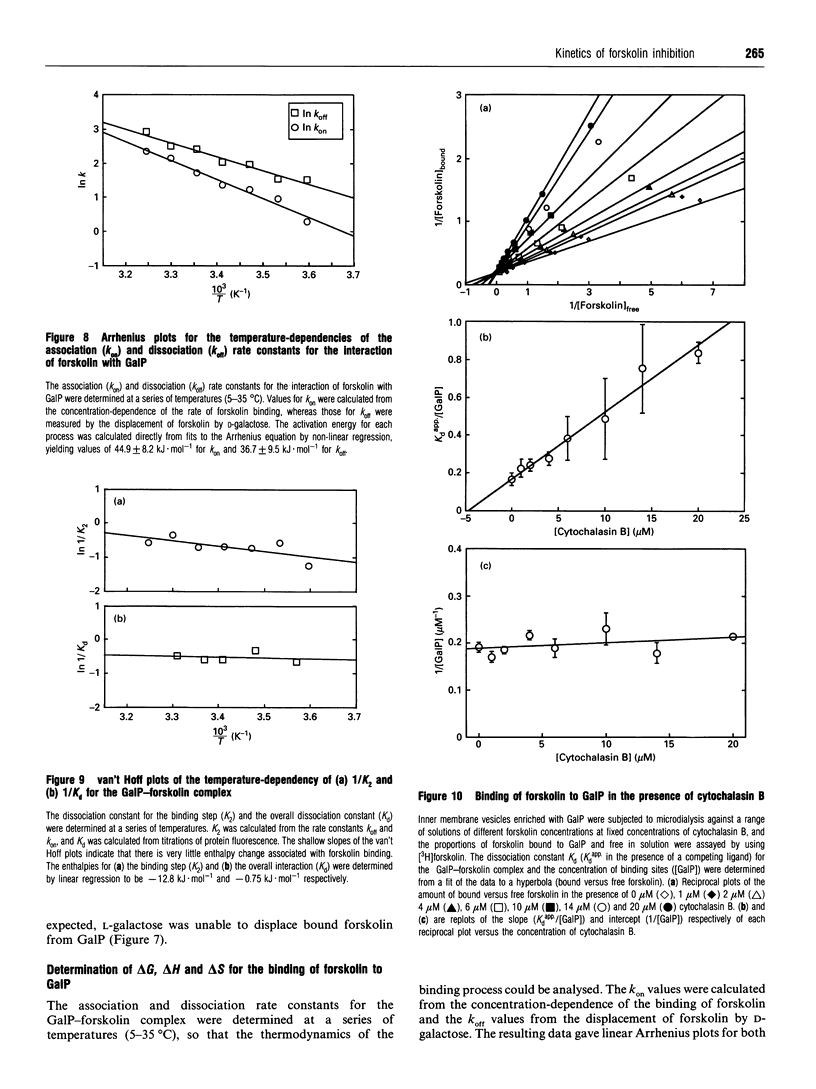
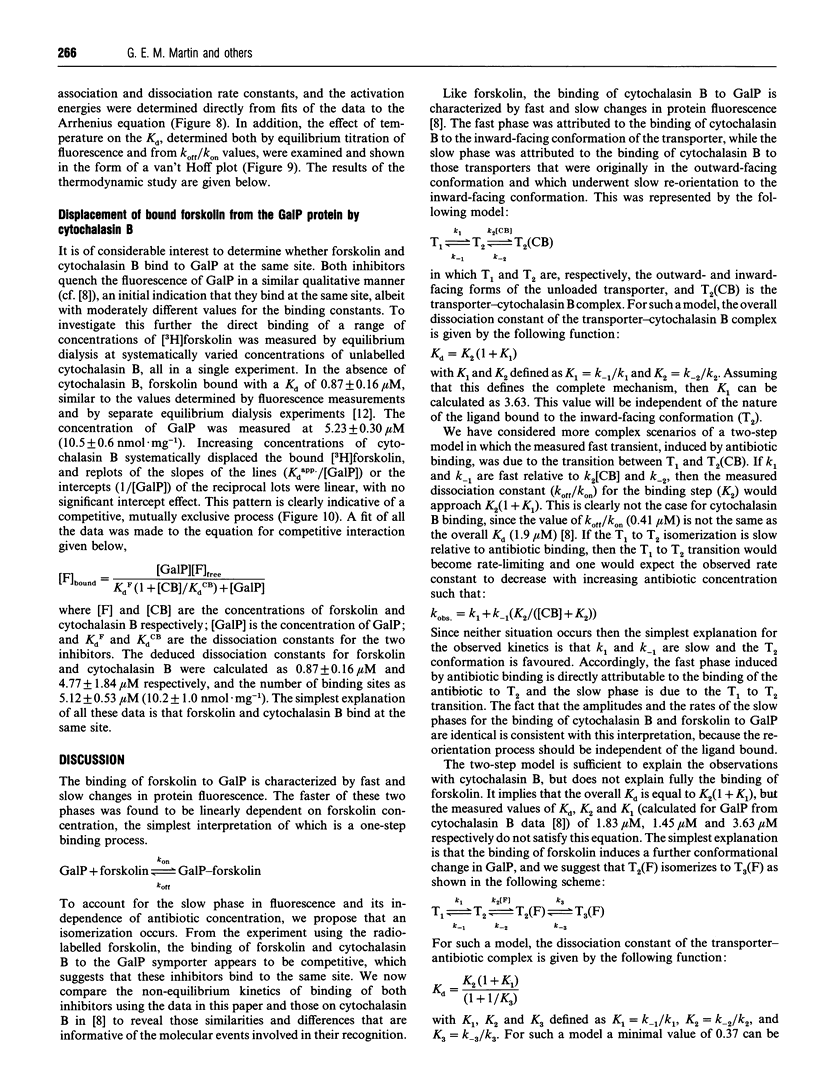
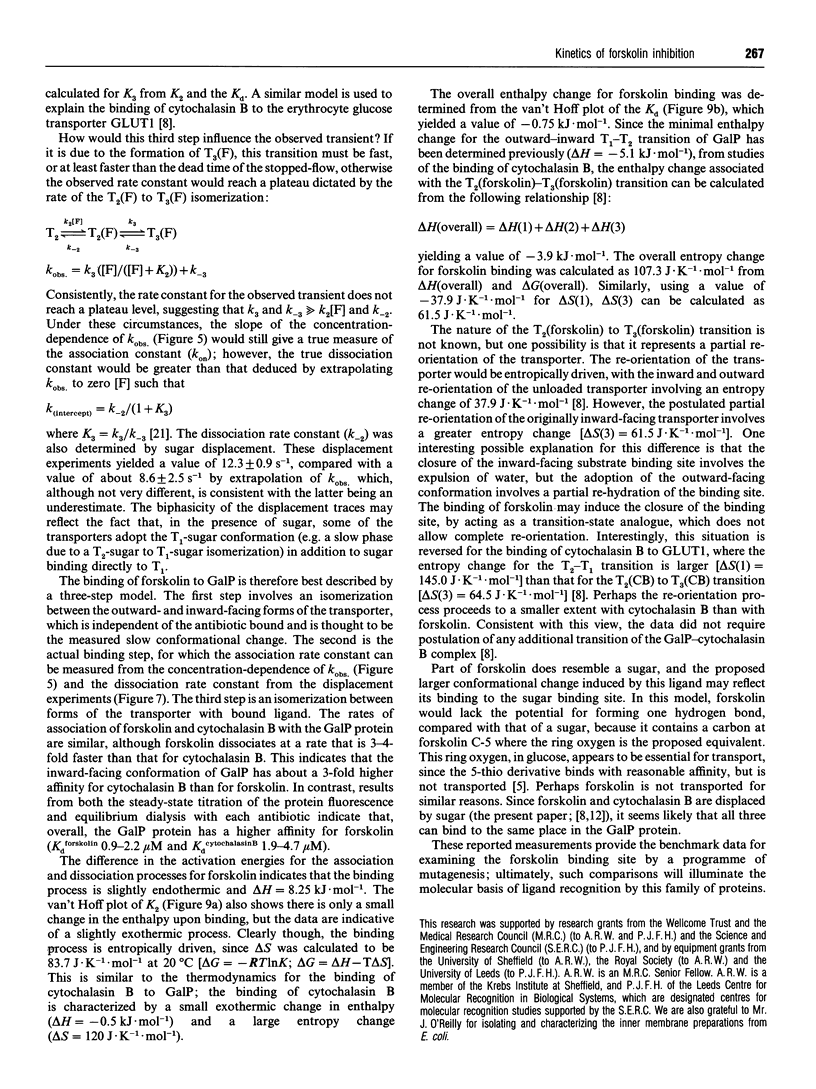
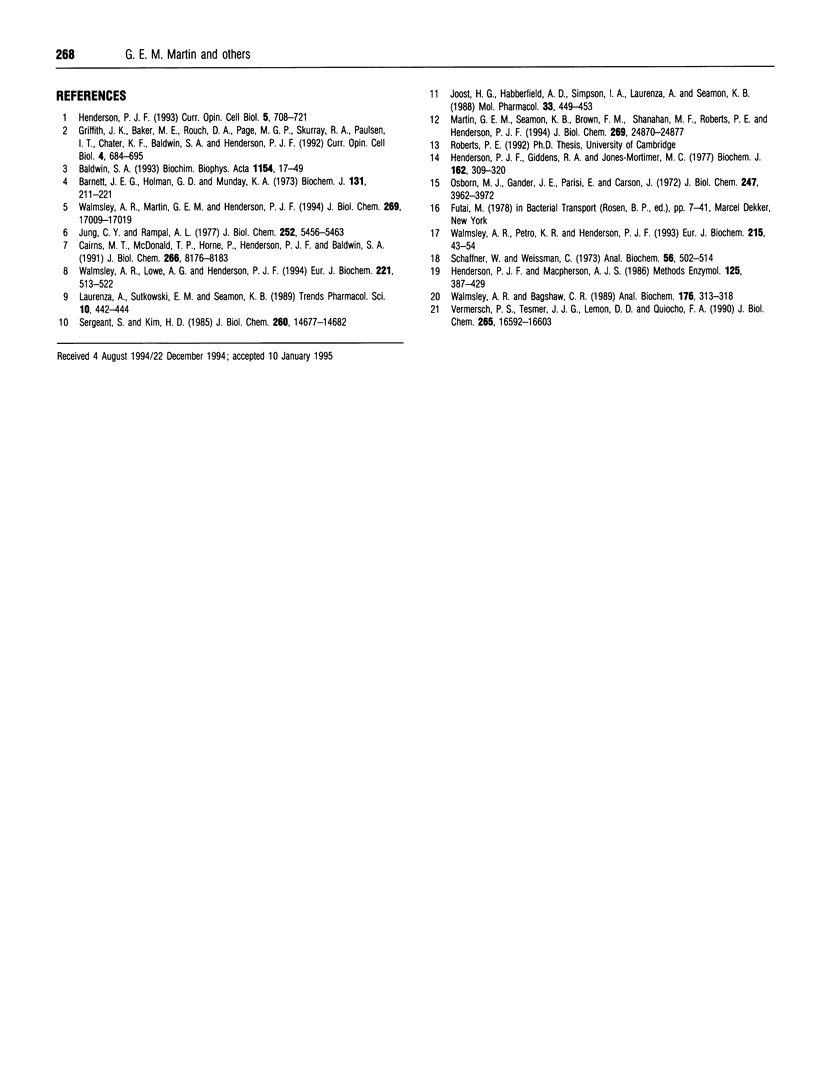
Selected References
These references are in PubMed. This may not be the complete list of references from this article.
- Baldwin S. A. Mammalian passive glucose transporters: members of an ubiquitous family of active and passive transport proteins. Biochim Biophys Acta. 1993 Jun 8;1154(1):17–49. doi: 10.1016/0304-4157(93)90015-g. [DOI] [PubMed] [Google Scholar]
- Barnett J. E., Holman G. D., Munday K. A. Structural requirements for binding to the sugar-transport system of the human erythrocyte. Biochem J. 1973 Feb;131(2):211–221. doi: 10.1042/bj1310211. [DOI] [PMC free article] [PubMed] [Google Scholar]
- Cairns M. T., McDonald T. P., Horne P., Henderson P. J., Baldwin S. A. Cytochalasin B as a probe of protein structure and substrate recognition by the galactose/H+ transporter of Escherichia coli. J Biol Chem. 1991 May 5;266(13):8176–8183. [PubMed] [Google Scholar]
- Griffith J. K., Baker M. E., Rouch D. A., Page M. G., Skurray R. A., Paulsen I. T., Chater K. F., Baldwin S. A., Henderson P. J. Membrane transport proteins: implications of sequence comparisons. Curr Opin Cell Biol. 1992 Aug;4(4):684–695. doi: 10.1016/0955-0674(92)90090-y. [DOI] [PubMed] [Google Scholar]
- Henderson P. J., Giddens R. A., Jones-Mortimer M. C. Transport of galactose, glucose and their molecular analogues by Escherichia coli K12. Biochem J. 1977 Feb 15;162(2):309–320. doi: 10.1042/bj1620309. [DOI] [PMC free article] [PubMed] [Google Scholar]
- Henderson P. J., Macpherson A. J. Assay, genetics, proteins, and reconstitution of proton-linked galactose, arabinose, and xylose transport systems of Escherichia coli. Methods Enzymol. 1986;125:387–429. doi: 10.1016/s0076-6879(86)25033-8. [DOI] [PubMed] [Google Scholar]
- Henderson P. J. The 12-transmembrane helix transporters. Curr Opin Cell Biol. 1993 Aug;5(4):708–721. doi: 10.1016/0955-0674(93)90144-f. [DOI] [PubMed] [Google Scholar]
- Joost H. G., Habberfield A. D., Simpson I. A., Laurenza A., Seamon K. B. Activation of adenylate cyclase and inhibition of glucose transport in rat adipocytes by forskolin analogues: structural determinants for distinct sites of action. Mol Pharmacol. 1988 Apr;33(4):449–453. [PubMed] [Google Scholar]
- Jung C. Y., Rampal A. L. Cytochalasin B binding sites and glucose transport carrier in human erythrocyte ghosts. J Biol Chem. 1977 Aug 10;252(15):5456–5463. [PubMed] [Google Scholar]
- Laurenza A., Sutkowski E. M., Seamon K. B. Forskolin: a specific stimulator of adenylyl cyclase or a diterpene with multiple sites of action? Trends Pharmacol Sci. 1989 Nov;10(11):442–447. doi: 10.1016/S0165-6147(89)80008-2. [DOI] [PubMed] [Google Scholar]
- Martin G. E., Seamon K. B., Brown F. M., Shanahan M. F., Roberts P. E., Henderson P. J. Forskolin specifically inhibits the bacterial galactose-H+ transport protein, GalP. J Biol Chem. 1994 Oct 7;269(40):24870–24877. [PubMed] [Google Scholar]
- Osborn M. J., Gander J. E., Parisi E., Carson J. Mechanism of assembly of the outer membrane of Salmonella typhimurium. Isolation and characterization of cytoplasmic and outer membrane. J Biol Chem. 1972 Jun 25;247(12):3962–3972. [PubMed] [Google Scholar]
- Schaffner W., Weissmann C. A rapid, sensitive, and specific method for the determination of protein in dilute solution. Anal Biochem. 1973 Dec;56(2):502–514. doi: 10.1016/0003-2697(73)90217-0. [DOI] [PubMed] [Google Scholar]
- Sergeant S., Kim H. D. Inhibition of 3-O-methylglucose transport in human erythrocytes by forskolin. J Biol Chem. 1985 Nov 25;260(27):14677–14682. [PubMed] [Google Scholar]
- Vermersch P. S., Tesmer J. J., Lemon D. D., Quiocho F. A. A Pro to Gly mutation in the hinge of the arabinose-binding protein enhances binding and alters specificity. Sugar-binding and crystallographic studies. J Biol Chem. 1990 Sep 25;265(27):16592–16603. [PubMed] [Google Scholar]
- Walmsley A. R., Bagshaw C. R. Logarithmic timebase for stopped-flow data acquisition and analysis. Anal Biochem. 1989 Feb 1;176(2):313–318. doi: 10.1016/0003-2697(89)90315-1. [DOI] [PubMed] [Google Scholar]
- Walmsley A. R., Lowe A. G., Henderson P. J. The kinetics and thermodynamics of the binding of cytochalasin B to sugar transporters. Eur J Biochem. 1994 Apr 1;221(1):513–522. doi: 10.1111/j.1432-1033.1994.tb18763.x. [DOI] [PubMed] [Google Scholar]
- Walmsley A. R., Martin G. E., Henderson P. J. 8-Anilino-1-naphthalenesulfonate is a fluorescent probe of conformational changes in the D-galactose-H+ symport protein of Escherichia coli. J Biol Chem. 1994 Jun 24;269(25):17009–17019. [PubMed] [Google Scholar]
- Walmsley A. R., Petro K. R., Henderson P. J. Equilibrium and transient kinetic studies of the binding of cytochalasin B to the L-arabinose-H+ symport protein of Escherichia coli. Determination of the sugar binding specificity of the L-arabinose-H+ symporter. Eur J Biochem. 1993 Jul 1;215(1):43–54. doi: 10.1111/j.1432-1033.1993.tb18005.x. [DOI] [PubMed] [Google Scholar]


